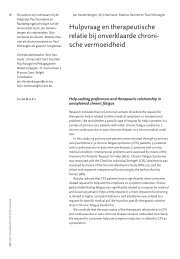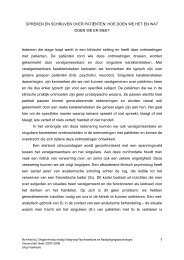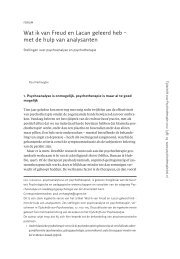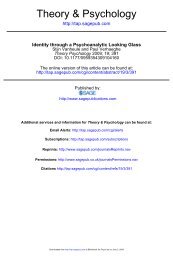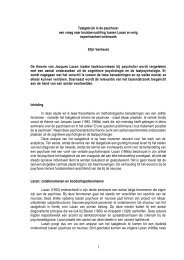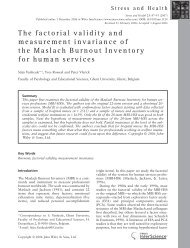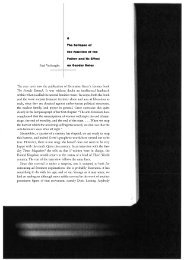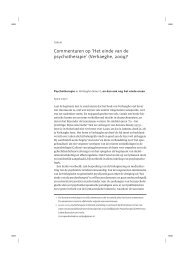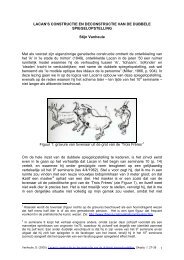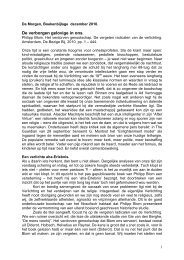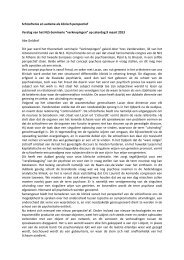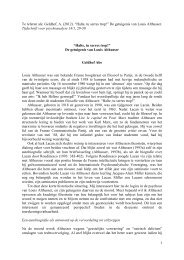psychotherapy and research
psychotherapy and research
psychotherapy and research
You also want an ePaper? Increase the reach of your titles
YUMPU automatically turns print PDFs into web optimized ePapers that Google loves.
STIJN VANHEULE 107Note1. This statistical term refers to extraneous variables that have an unintentionaleffect on the variables under study.ReferencesAblon, J.S., Levy, R.A. & Katzenstein, T. (2006) Beyond br<strong>and</strong> names of <strong>psychotherapy</strong>:Identifying empirically supported change processes. Psychotherapy:Theory, Research, Practice, Training 43: 216–31.Allison, D.B., Franklin, R.D. & Gorman, B.S. (1997) Design <strong>and</strong> Analysis of Single-Case Research. Mahwah, NJ: Erlbaum.American Psychiatric Association (2000) Diagnostic <strong>and</strong> Statistical Manual ofMental Disorders, 4th Edn, Text Revision. Washington, DC: American PsychiatricAssociation.Bagby, R.M., Quilty, L.C., De Fruyt, F., Roll<strong>and</strong>, J.-P., Kennedy, S.H. & Rouillon, F.(2008) Dimensional personality traits <strong>and</strong> treatment outcome in patients withmajor depressive disorder. Journal of Affective Disorders 107: S87–S88.Bateman, A. & Fonagy, P. (2008) Eight-year follow-up of patients treated for borderlinepersonality disorder: Mentalization-based treatment versus treatment asusual. American Journal of Psychiatry 162(12): 2387–9.Beutel, M.E., Rasting, M., Stuhr, U., Rüger, B. & Leuzinger-Bohleber, M. (2004)Assessing the impact of psychoanalyses <strong>and</strong> long-term psychoanalytic therapies onhealth care utilization <strong>and</strong> costs. Psychotherapy Research 14: 146–60.Blatt, S.J. & Zuroff, D.C. (2005) Empirical evaluation of the assumptions in identifyingevidence-based treatments in mental health. Clinical Psychology Review 25:459–86.Borckardt, J.J., Nash, M.R., Murphy, M.D., Moore, M., Shaw, D. & O’Neil, P. (2008)Clinical practice as natural laboratory for <strong>psychotherapy</strong> <strong>research</strong>. American Psychologist63: 77–95.Briggs, S., Maltsberger, J.T., Goldblatt, M.J., Linder, R. & Fiedler, G. (2006) Assessing<strong>and</strong> engaging suicidal teenagers in psychoanalytic <strong>psychotherapy</strong>: A case consultation.Archives of Suicide Research 10: 323–37.Cosgrove, L., Krimsky, S., Vijayaraghavan, M. & Schneider, L. (2006) Financial tiesbetween DSM-IV panel members <strong>and</strong> the pharmaceutical industry. Psychotherapy<strong>and</strong> Psychosomatics 75: 154–60.Eccles, M. & Mason, J. (2001) How to develop cost-conscious guidelines. HealthTechnology Assessment 5: 16.Fonagy, P. (2006) Evidence-based psychodynamic psychotherapies. In: PDM TaskForce (eds), Psychodynamic Diagnostic Manual. Silver Spring, MD: Alliance ofPsychoanalytic Organizations.Fonagy, P., Gergely, G., Jurist, E. & Target, M. (2002) Affect Regulation, Mentalization,<strong>and</strong> the Development of the Self. New York, NY: Other Press.Fonagy, P., Roth, A. & Higgitt, A. (2005) The outcome of psychodynamic<strong>psychotherapy</strong> for psychological disorders. Clinical Neuroscience Research 4:367–77.Freshwater, D. & Rolfe, G. (2004) Deconstructing Evidence-based Practice.Abingdon: Routledge.Frovenholt, J., Bragesjo, M., Clinton, D. & S<strong>and</strong>ell, R. (2007) How do experiences ofpsychiatric care affect the perceived credibility of different forms of <strong>psychotherapy</strong>?Psychology <strong>and</strong> Psychotherapy – Theory, Research <strong>and</strong> Practice 80: 205–15.Goldfried, M.R. (2000) Consensus in <strong>psychotherapy</strong> <strong>research</strong> <strong>and</strong> practice: Wherehave all the findings gone? Psychotherapy Research 10: 1–16.



